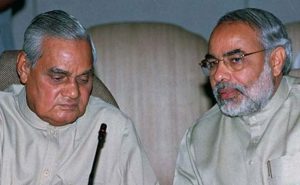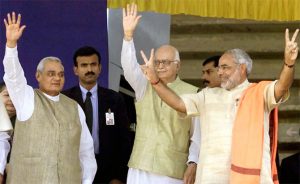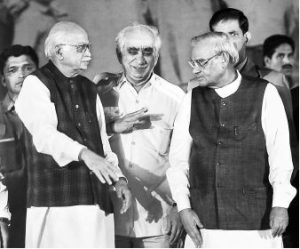A story of differing Quo-Vadis
The BJP as a political party has had several individuals who contributed to its formidable growth across the country. Here is an account of Vajpayee and Modi.
The formative years of the party and Vajpayee
 W hen Shyama Prasad Mukherjee founded the Bharatiya Jan Sangh, Atal Bihari Vajpayee was seen as a natural attraction since he was an Arya Samaj activist. Following the death of Shyama Prasad Mukherjee, Vajpayee was identified as the successor. Vajpayee and other emerging leaders like Balraj Madhok, L K Advani and Deendayal Upadhyaya made notable contributions to the growth, though limited to the organisation.
W hen Shyama Prasad Mukherjee founded the Bharatiya Jan Sangh, Atal Bihari Vajpayee was seen as a natural attraction since he was an Arya Samaj activist. Following the death of Shyama Prasad Mukherjee, Vajpayee was identified as the successor. Vajpayee and other emerging leaders like Balraj Madhok, L K Advani and Deendayal Upadhyaya made notable contributions to the growth, though limited to the organisation.
Vajpayee was a charismatic young orator who attracted large crowds in the ‘Hindi Belt’. He also attained the appreciation of Nehru who identified him as a potential future Prime Minister of the country. He cultivated a habit of winning friends even among foes. He was approachable even by a commoner and gave an ear to their view points and suggestions. This cohesiveness made him accommodate 24 parties in his coalition government.
Vajpayee was under allegations, gossips and other revenge politics for quite some time. He waited for the right opportunity and made slow moves to reach the high in his political career. He was publicly criticised even at personal terms, by his hardcore ‘Hindutva’ colleagues.
But all the time, he was supported by the RSS leadership for various reasons. His patient attitude brought the organisation in the frontline among the educated middle class in the country. Even hardcore saffron ride by leaders like Advani which brought electoral dividends did not stand in the long run.
Today, very few in the party remember about the Ayodhya Ram Temple movement and the only reminder is the Supreme Court of India which hears the litigation with respect to the issue. Narendra Modi had a big mandate in 2014 but it was only seen as his personal victory rather than the party’s success.
“Vajpayee’s charisma has been such that opposition parties of the INC like Mamata Banarjee once said that her party was in the coalition because of him; today, Mamata’s stand is clearly with the congress to bring down the Modi government.”
Many allies of the Modi government have allegedly shown their dissatisfaction over his treatment of them. BJP under Modi seems to gobble the base of their allies at the cost of alliance and coalition government. Shiv Sena, which once ruled Maharashtra, lost to their ally while contesting against each other during the assembly elections. Facing similar heat, TDP and TRS distanced themselves from the BJP and are now pursuing their larger national role. During the Vajpayee era, AIADMK was the lone party, a major partner, to withdraw its support.
 Modi Vs Vajpayee
Modi Vs Vajpayee
Vajpayee wanted to remove Modi from his post of CM of Gujarat in the aftermath of communal violence in 2002. In the national executive meeting of the party in Goa, several voices were raised in favour of Modi when he announced that he would quit the post. Vajpayee was forced to accept the rejection in the meeting by several participants. Arun Shourie and Jaswant Singh, both ardent followers of Vajpayee later shared the incidents. It was said that Advani saved the chair for Modi. Otherwise, Modi could have been forgotten by this time.
The hardcore Hindutva of the BJP had finally won over moderates. Accidentally or not, the same Goa meeting in 2013 of the highest party forum elected Modi as the campaign chief for the 2014 poll. Advani was supposedly invited for the meet. But he did not attend the meet; first-ever in his political life to miss such an important event.
When the question of Presidency arose, Ram Nath Kovind was selected by a committee. Advani was the campaign committee chief in the 2009 elections. But he could not win the reign. Making him the President was just a general expectation among the public and media but was not considered by the party.
“Also, Modi wanted a non-influential person in the President’s post. It is noted that Indira Gandhi too chose many Presidents by her own choice.”
 Vajpayee made A P J Abdul Kalam as the President with consensus among the allies and even few opposition parties. It was in July 2002, within six months of Gujarat riots. Vajpayee admitted the error of such large scale riots in a BJP-ruled state in a Singapore press conference. Modi was silent over the attacks on minorities and lower castes since the beginning. He once condemned both loose talks and mobocracy to bring order within the party and affiliates.
Vajpayee made A P J Abdul Kalam as the President with consensus among the allies and even few opposition parties. It was in July 2002, within six months of Gujarat riots. Vajpayee admitted the error of such large scale riots in a BJP-ruled state in a Singapore press conference. Modi was silent over the attacks on minorities and lower castes since the beginning. He once condemned both loose talks and mobocracy to bring order within the party and affiliates.
Vajpayee has had friends who were not part of RSS. He regularly met editors and other intellectuals to get their thoughts and suggestions. Modi avoids press meets and has given interviews to selected editors in the past. In an election year, the incumbent PM has to talk more than ever. Modi believes in ‘Karya’ rather than talks. Demonetisation is an example.
Foreign relations under Vajpayee were smooth enough through the MEA, while other parts of the world encountered serious wars and clashes including neighbourhoods of Pakistan, Sri Lanka and Nepal. At present, India follows the same policy of UPA rather than the NDA period under Vajpayee. Modi’s trips abroad are claimed as a long-term strategy. Does it curb anti-India euphoria among the neighbourhood politicians and the regimes? Doubts are often expressed; answers are not pointed out.
Ideologically both Vajpayee and Modi are Quo-Vadis, who have learnt and risen from experience. But their style and compassion differ much in thought and action. Vajpayee has been a charioteer, steering the party during hard times and managed to keep it intact despite several defeats. Modi’s charisma is enveloping despite his shortcomings. One has a poetic sense with soft, long-term nurturing of ideology, and the other is a hurricane in approach and demands result.
